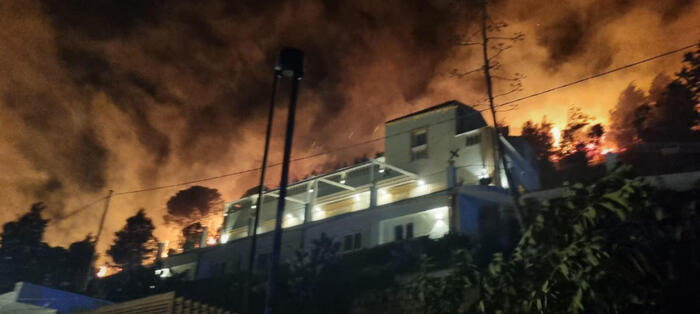It is recommended to walk along Avenida Montes de Oca, the old Calle Larga, with the view up.
From its source on Avenida Caseros, between buildings with Buenos Aires
belle époque
style facades , to its mouth at the Riachuelo, where, on a brick wall of a huge warehouse, we see the neighborhood symbols worked with venecitas: boats, immigrants, shacks, workers , factories, Gardel, tango.
Beautiful auction for
twenty-three blocks loaded with stories, myths and legends
that span several centuries.
Soldiers marched down Calle Larga during the English Invasions and the Reconquest, cars with those killed during the yellow fever epidemic, crowds of workers from the suburbs on October 17, 1945, already in the Montes de Oca era.
La Calle Larga was in the first national fiction, such as
Amalia
(1855), by José Mármol, and in notable paintings such as
La Calle Larga de Barracas
(1858), by Juan Carlos Morel.
Calle Larga even had its notable historian: Enrique Horacio Puccia (1910-1995)), founding member of the Central Board of Historical Studies of the City of Buenos Aires, illustrious citizen of CABA, resident of Barracas and, of course, of the Montes de Oca Avenue. He lived at 1300, on the site where, at the end of the 19th century, the field of the first Argentine soccer champion, the Saint Andrews Athletic Club, had been.
The team, formed in 1890 by British railway workers, won the 1891 final of the Argentine Association Football League against Old Caledonian, 1-0, and celebrated there, in their field on Calle Larga.
Graciela Puccia, Enrique's daughter, awaits us nearby: in El Progreso, a notable bar founded in 1942, at the corner of Montes de Oca at 1700.
Vintage Eden without imposition
, genuine Buenos Aires cafeteria, indifferent to the impersonal landscape of franchises.
A place of neighborhood memories and relics treasured by its owner, César Moreno, who inherited the bar from his parents and maintains it with more love than calculation, now excited by the great Scrabble players who meet there every Friday.
Sitting at a wooden table next to a window, Graciela, who is in charge of the Board of Historical Studies of Barracas, provides us with material on this avenue, including
her father 's book
Historia de la Calle Larga .
We obtain information to fill all the 2023 editions of
Viva
.
The Cambaceres mansion (Av. Montes de Oca 121), where Rufina Cambaceres died.
Photo: Martin Bonetto.
Great landmarks of Calle Larga
In a chaotic outburst, we review milestones in Montes de Oca.
The procession of Santa Lucía
, every December 13, with the Virgin making her way through the rain of jasmine thrown by the crowd – from the street and the balconies – along the avenue.
The collapse, on the night of June 10, 1970, of the 14-story building at Montes de Oca 680
;
the despair, the rubble, the 31 dead.
The case of the "barracks dismemberer"
, Jorge Burgos, who in February 1955, in his apartment at Montes de Oca 280, murdered 27-year-old Alcira Methyger, dismembered her in the bathtub, scattered her remains throughout Greater Buenos Aires and threw his head into the Creek.
(After being released, he continued to live there until his death.)
There are more pleasant memories, obviously, like the afternoons and nights at La Banderita, in Montes de Oca and Suárez.
La Banderita: in the mid-19th century, on Calle Larga, it was a grocery store and cart post, which later mutated until it became a bar that closed in 1983. Among its patrons were Benito Quinquela Martín and Juan de Dios Filiberto.
Another historic grocery store on Calle Larga –populated in the 19th century by aristocratic villas– was La Paloma, where it was said that the grocery store of Santa Lucía, a waltz celebrity, worked.
On both sides of this artery, which before Calle Larga was part of the Camino Real del Sur, at the end of the 17th century and throughout the 18th century, precarious constructions were built to store leather and salted meats on the banks of the Riachuelo:
the barracks
.
The cuarteador -who appears on the Barracas shield- moved that merchandise with horses.
The barracks gave the name to the neighborhood (1853).
Later, in 1887, Barracas was incorporated into the Federal Capital
.
The era of factories began, such as Bagley's, installed in 1892 at Montes de Oca 253 at the behest of American Melville S. Bagley, creator of Hesperidin.
The labor movements were also strengthening, which in Barracas would have combative representatives.
On February 2, 1892, the Circle of Catholic Workers of Santa Lucía was founded at Montes de Oca 972, and in 1902 it was moved to 318.
The parish of Santa Lucía, in Montes de Oca 550. Photo: Martín Bonetto.
(Un)protected children
We are in Montes de Oca at zero, summer of 2023. We begin a walk with our attention focused on majestic buildings from the 19th century.
At Montes de Oca 80 we stop at
Casa Cuna, the oldest pediatric hospital in the Americas
.
In the institution, founded on August 7, 1779 as the Casa de Niños Expósitos – in present-day Peru and Alsina –
sick or abandoned children were cared for: illegitimate newborns, incestuous children or the product of rape, babies of unmarried girls or illicit unions, outside of marriage
.
At that time it was customary that when twins were born one of the babies was discarded.
Many children died of hunger, thirst or cold;
others, drowned in street puddles or eaten by dogs or pigs, or run over by carriages in the dark.
In 1873,
after the yellow fever epidemic of 1871
, the Casa de Niños Expósitos was transferred to premises of the Instituto Sanitario Modelo, owned by Félix Lassana, owner of a property surrounded by gardens at the top of the Calle Larga ravine.
In February 1874 a chapel was inaugurated;
In 1891 the children's reception office was created: in 1911 land in Montes de Oca and Caseros was expropriated to expand the facilities.
More than a century later, in 2020, at the beginning of the Covid pandemic, on Montes de Oca (name that evokes Manuel Augusto Montes de Oca, a doctor who attended the sick due to the cholera epidemics of 1867 and 1868 and fever yellow from 1871) an Emergency Fever Unit was installed.
There, at the door of the Casa Cuna, swabs were carried out: the unit covered three quarters of the width of the avenue.
In addition
, a SAME heliport was enabled,
still available for emergencies.
At 110, within the Casa Cuna property, there is a dazzling mansion riddled with mythologies,
the French-style palace that Eustoquio Díaz Vélez
had built in 1880, with a well-kept garden, typical of the high-society villas of those years.
At the entrance, there is still a large arch topped at the top by
the image of a lion
.
Upon entering, an impressive sculpture: another lion with a ferocious gesture attacks a man, resting its claws on his head.
A widespread urban legend is that Eustoquio – married to his niece Josefa Cano Díaz Vélez
– had two lions brought from Africa that walked through the garden during the day
and were caged at night.
During the engagement party of one of the Díaz Vélez daughters with Juan Aristóbulo Pittamiglio, also a rancher, one of the lions escaped –supposedly– and
attacked the groom
, to the astonishment of the guests and the orchestra that animated the meeting .
Amid the screams of fright, the owner of the villa went to his office,
took a shotgun and killed the animal with several shots
.
But Pittamiglio died of his injuries and, at the same time, his daughter committed suicide with cyanide after a mass in Santa Felicitas.
The scene of the hypothetical attack was reflected in the statue near the entrance, half hidden by the vegetation.
Every weekend, many tourists visit the place and listen to the guides narrate the story with slight variations.
They can only see the mansion – which in 1917 was offered to President Hipólito Yrigoyen as a home – from the outside, because the place is not public: the Foundation for the Housing and Work of the Seriously Crippled works there.
Bar El Progreso: Montes de Oca at 1700. Photo: Martín Bonetto.
Rufina's double death
Right in front of the House of the Lions is
the fifth of Cambaceres
, where we see an imposing staircase that ascends to the entrance of a small palace.
Avenida Montes de Oca 121, where the Republic of Lebanon Technical School is located today.
On May 31, 1902, Rufina Cambaceres, daughter of the writer Eugenio Cambaceres and the dancer Luisa Bacichi (who was going to be Yrigoyen's partner after the death of her husband) suddenly died there –on her birthday.
There are two disturbing myths.
A romantic one: that Rufina was in love with Don Hipólito, much older than her, and that he disputed that passion with her mother.
The other is morbid: that she did not die on May 31, 1902, but suffered a trance attack and was buried alive in Recoleta
.
It was said that her coffin appeared the day after the burial out of place, that the corpse lay face down, that there were scratches on her face, body and inside the coffin lid, that the jewels buried with Rufina were still in the coffin. coffin, which had not been the work of looters.
In summary:
it was speculated that she had woken up inside the coffin and that, desperate, she made all kinds of attempts to give notice, until she died of suffocation
.
The story – unchecked – caused such an impact that, a few meters from the Cambaceres cemetery, a man had a bell system installed to alert from his coffin in case he was buried alive.
Later on, the norm was instituted that obliges to watch over the bodies for at least twenty-four hours.
The church in memory of Felicitas was inaugurated in 1876. Photo: Martín Bonetto.
Felicitas crime
In the middle of the 19th century, the block of Montes de Oca, Pinzón, Azara and Brandsen,
today Plaza Colombia
, was
the country house of Martín de Álzaga
, later inherited by his widow, Felicitas Guerrero, who had been forced by her father to marry this landowner on June 2, 1864, when she was 18 years old and he was 50.
Since Álzaga's death in 1870,
many men became suitors for Felicitas
, who was beautiful as well as rich.
Enrique Ocampo, future great-uncle of Victoria Ocampo, was one of them.
But Felicitas –whose two children with Álzaga had died very young;
one of yellow fever– she fell in love with Samuel Sáenz Valiente, a wealthy young man who had behaved like a gentleman when he met her by chance during a storm.
At the time, he and Felicitas announced their engagement;
the party was going to be at the rest house of the Guerrero family.
But on January 29, 1872,
Ocampo broke into the mansion and asked to speak with Felicitas
.
After an argument, he shot her in the back: her bullet hit her right shoulder blade and deflected toward her spine.
Felicitas' brother and cousin came to help her and, in that room,
Ocampo also died, wounded with a firearm
.
Judge Ángel Carraza ruled suicide, although some versions maintained that Guerrero's relatives had killed him.
Felicitas was in agony for a few hours and died in the early morning of January 30
.
She was buried in Recoleta.
In his memory, the parents commissioned the architect Ernesto Bunge to build a church;
Santa Felicitas, in an eclectic German style, was inaugurated in 1876, in front of the Guerrero estate.
Then, the family had one of the hidden jewels of Barracas built,
the Hidden Temple
, a neo-Gothic cathedral built in 1893 inside a building with no access to the street, never consecrated as a sacred space (the parish priest who was in charge of the work committed suicide on site), with 28 French stained glass windows made by GP Dagrant.
In 1909, the building where Ocampo had mortally wounded Felicitas became the Barracas Municipal Office.
In 1937, in the place where the mansion stood – demolished – Plaza Colombia was founded.
Now, in front of the Church, we read a poster that summarizes the murder of the young woman;
Above the bars, we see knotted white handkerchiefs: they belong to people who, in the 21st century, despite everything, ask Felicitas to help them get married.
Acknowledgments: Graciela Puccia (Enrique H. Puccia Historical Archive), César Moreno (Bar El Progreso), Ellen Hendi (Santa Felicitas Historical Complex).
look also
Tunnels of Buenos Aires: the fascinating stories of a trip to the past
Parque Lezama: the magical history of the place where Buenos Aires was born








/cloudfront-eu-central-1.images.arcpublishing.com/prisa/QSB5XZRIWJDWRISSO27AUL5EKM.jpg)